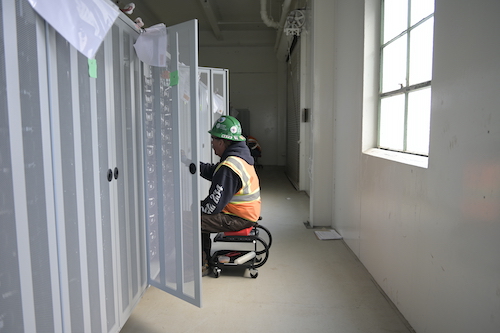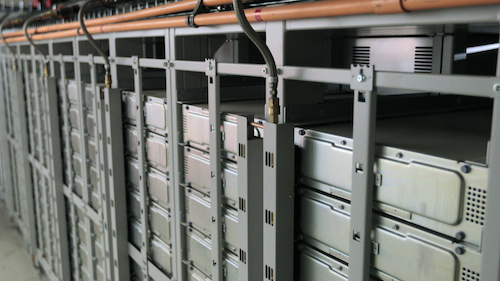The twin smokestacks of Moss Landing power station have been a landmark on the Monterey Bay coast for more than 50 years. They tower over the bright green fields of artichokes and are visible from Santa Cruz to Monterey.
But members of Castroville, Calif., Local 234 recently transformed those towers into a global landmark, turning an outdated oil-burning power station into a cutting-edge step toward solving the North American power grid's biggest problem.

|

|
| Local 234 members installed nearly 100,000 batteries, 22 in each rack, weighing nearly 12,000 tons in total.
|
Over the last year, more than 135 Local 234 members filled the cavernous hall of the decommissioned power station with enough batteries to power nearly a quarter million houses for up to four hours.
At 400 megawatts, Moss Landing became the largest grid-scale storage facility in the world when it was commissioned by PG&E in December. It far outstrips the previous record holder, the 250 MW Gateway Energy Storage facility in San Diego that came online last year.
For scale, in 2018, just 311 MW of grid-scale lithium-ion battery storage was brought online in total.
"It is a sight to see for sure," Local 234 Business Manager Lamont Adams said of Moss Landing's sea of battery racks.
For this first phase, Adams said, workers cleared the original powerhouse to hold nearly 100,000 batteries, 22 in each rack, wired in series with safety modules between each rack. The installation's weight overwhelmed the floor, which was designed to hold turbines, so the structure had to be reinforced and rebuilt to hold 12,000 tons.
"Those DC batteries are no joke. They are heavy, and DC power can be very dangerous if you don't know what you are doing," he said.
The Moss Landing project has the potential to keep growing and providing more jobs in the future. The plant's owner, Vistra Energy, said the location could expand battery capacity up to 1,600 MW/6,000 MWh, a boon to the small local which primarily serves the agricultural communities of the Central Coast.
The higher wages and never-ending walkthroughs at San Jose Local 332 and San Francisco Local 6 are a constant pull for Local 234 members, Adams said. Having a reliable, high-scale job close by has made the choice to stay home a lot easier.
Once all the construction is finished, Local 234 will hand it off to their brothers and sisters at Vacaville Local 1245, who will run and maintain the facility for employer PG&E.
Solving the Grid's Biggest Problem
"The North American power grid is the most complicated and expensive machine in human history. It is also the most important to our economy, but it wasn't designed for intermittent generation like solar and wind," said Utility Director Donnie Colston. "Grid-scale storage is not only one of the ways we bridge that gap, but like at Moss Landing, it is evidence than decarbonizing power generation can provide good jobs."
For most of the history of the U.S. power grid there was no way to keep energy in reserve for later use. Every megawatt that left a generation station had to be used at that moment.
But that wasn't a drawback as long as both supply and demand were reasonably predictable, and for the most part, they are. Yearly power demand peaks in summer when air conditioners are running full blast. Daily energy use peaks, outside of anomalies like a global pandemic, when commuters get home and a nation cooks its dinners, turns on its lights and flips on its televisions. Variation happened, but within relatively small bands, and long-term growth was on the scale of years.
Power production was, if anything, more predictable. The majority was supplied by baseload generation that was nearly always on and at the same level, mostly massive turbines spun up by steam from boilers heated by coal, nuclear and natural gas. When demand spiked, less efficient peaker plants — usually powered by natural gas — would spin up quickly and make up the difference.
Renewables are different. They produce most of their power when demand is low and switch off when demand peaks. As renewables penetrate more deeply, if no changes are made, that variability goes from a nuisance to a genuine problem for two reasons.
First, the misalignment of demand and supply will simply be harder to cover. Baseload coal and nuclear plants can't just turn on and serve up power on demand when the sun sets. Building more peaker plants — as is happening — solves some of the problem, but they are less efficient in general, especially compared to nuclear.
Second, because renewables produce energy so cheaply, they make legacy baseload generation economically unsustainable. So even though the grid needs the power baseload sources produce, the market won't pay them enough to stay in business.
"We are going to build more and more renewables. We need to make it more reliable," Colston said. "Every baseload generation plant that shuts down because the economics don't make sense makes our power grid more precarious."
Today, the most economic storage system is pumped hydroelectric — using excess power to fill reservoirs and then letting the water run back out when the power is needed — but that can only work in some locations, and very few of those are near desert solar farms.
There are dozens of possibilities being used, including molten salts superheated by concentrated sunlight and 4-ton flywheels floating on magnets inside a near-vacuum. For today, the cheapest, most flexible form of grid storage is batteries, and more are on the way.
"Energy storage is one of the missing pieces we will need to transition to a carbon-free grid over the next few decades. This project is promising and shows that green jobs can be good jobs when they are union jobs," said Construction and Maintenance Director Mike Richard.
A 2019 National Renewable Energy Laboratory study predicted that 150 gigawatts of the nation's 261 GW peaking fleet were likely to retire over the next 20 years. The study suggested that 28 GW of 4-hour battery storage will be needed to help fill that gap in peaking capacity.
And Moss Landing will be a major part of meeting that demand, likely breaking its own record before the year is out. This was just Phase I, Adams said. He expects three, 100 MW additions already underway, will peak out at a 40-person crew and wrap up by summer.
"The state is trying to go completely renewable by 2040, so they are trying to replace a lot of the standby fossil fuel plants with energy storage, with batteries," Adams said. "That is the drive."
The state's growing solar generation infrastructure will charge the facility's batteries during the day and release power primarily at night. It will help solve renewable energy's biggest flaw — reliability.
Building Where the Infrastructure Exists
To meet its carbon-free goal, California will need hundreds more megawatts of storage, and the IBEW will be a major part of making that happen.
Reusing decommissioned fossil fuel plants is common because they are increasingly vacant large industrial sites with existing transmission infrastructure in place. But more and more, generators are siting storage on the solar and wind farms where the energy is produced.
Driving it is a state procurement mandate of 1.8 GW of energy storage, 500 MW of which must be behind-the-meter and 1 GW of which the California PUC is targeting for installation by 2026.
The partially complete 500 MW Maverick solar-storage project in the jurisdiction of Riverside Local 440 is likely to overtake Moss Landing, but probably not for long.
Los Angeles Local 11 and Dublin Local 595 each have major storage projects done, underway or on the books.
And the growth of storage is not limited to the West Coast.
New Jersey is on track to procure 600 MW of storage by the end of this year, rising to 2 GW by 2030, said Third District International Representative Wyatt Earp.
In New York, any hope of meeting the state's zero-emissions target of 2040 is expected to require 1.8 GWh of storage by 2025 and 3 GWh by 2030.
But even if an extensive network of storage is built, there is still a place for a diverse generation portfolio, Colston said.
Battery projects, he said, are crucial to solving some of the problems renewables create, but much more has to be done to save existing baseload generation, expand the transmission grid and reform markets that collapse under entirely predictable stresses.
"This facility is a model for the future and fantastic news, but we still need an answer for baseload generation now," Colston said. "As Langston Hughes said, 'We cannot live on tomorrow's bread.'"